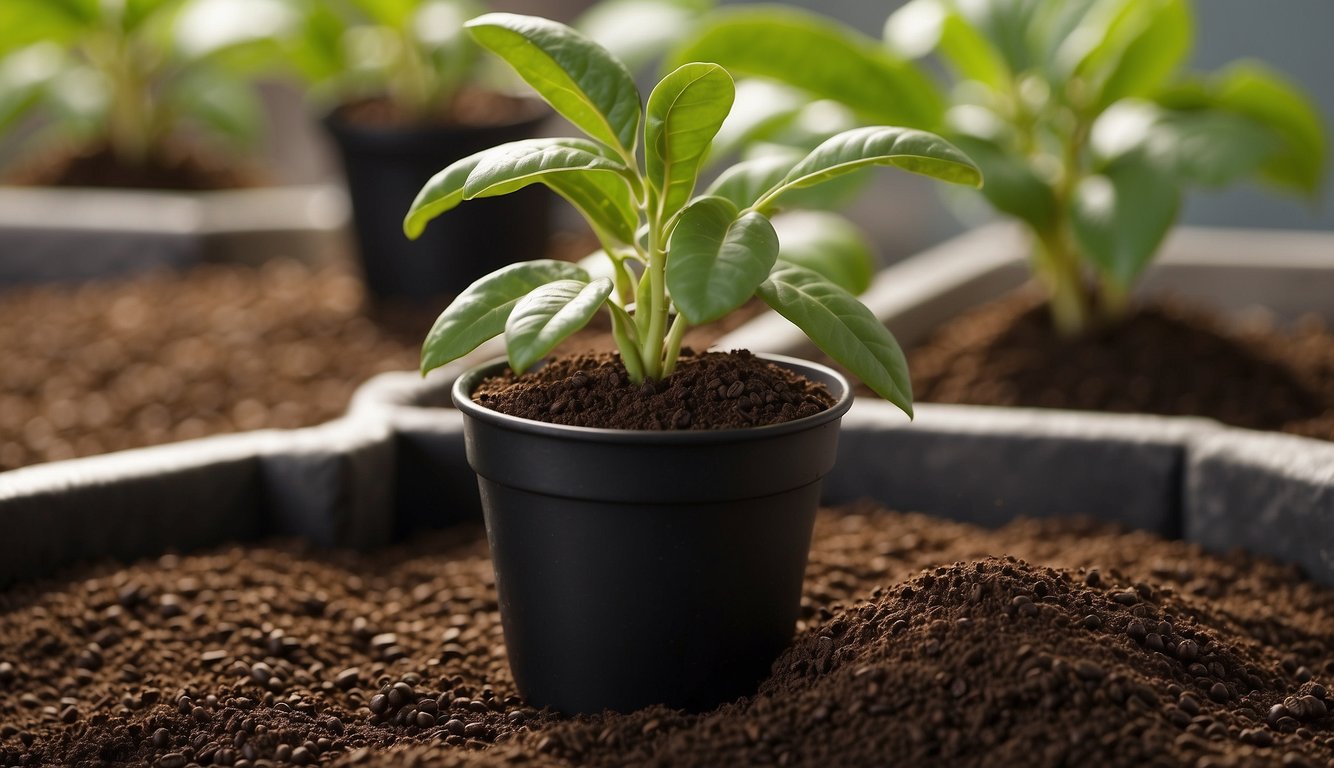TheHerbProf.com is a treasure trove of knowledge for those interested in natural healing and herbal remedies. The website is run by Paul Johnston MD. A naturopathic who has not only received extensive education in the field but also has personal experience in self-healing.
How to Use Coffee Grounds in Potted Plants? If you’re a coffee lover, you may have wondered what to do with all the leftover coffee grounds. One great way to put them to use is by adding them to your potted plants. Coffee grounds can be a beneficial addition to the soil, providing nutrients that can help your plants grow and thrive.
Before adding coffee grounds to your potted plants, it’s important to understand how to use them properly. While coffee grounds can be a great source of nitrogen, they can also be acidic, which can be harmful to some plants. It’s best to use coffee grounds sparingly and only with plants that can tolerate more acidic soil. Additionally, it’s important to avoid adding coffee grounds directly to the soil, as this can cause mold to develop. Instead, mix the coffee grounds with other organic material, such as compost or potting soil, before adding them to your plants.
Overall, using coffee grounds in potted plants can be a great way to give your plants an extra boost of nutrients. However, it’s important to use them properly and only with plants that can tolerate more acidic soil. With a little bit of knowledge and care, you can turn your leftover coffee grounds into a beneficial addition to your indoor garden.
Benefits of Coffee Grounds for Potted Plants
As a plant enthusiast, I have found that coffee grounds can be an excellent addition to potted plants. Not only do they provide a natural source of nutrients, but they can also help improve soil structure and act as a natural pest deterrent. Here are some of the benefits of using coffee grounds in potted plants.
Nutrient-Rich Organic Matter
Coffee grounds are rich in nutrients that are essential for plant growth. They contain nitrogen, phosphorus, potassium, and micronutrients such as calcium, magnesium, and iron. These nutrients can help improve soil health and promote plant growth. Coffee grounds are also a great source of organic matter, which can help improve soil structure and water retention.
Improved Soil Structure and Aeration
Coffee grounds can help improve soil structure and aeration. They are slightly acidic, which can help break down clay soils and improve drainage. Adding coffee grounds to potted plants can help create a loose and crumbly soil that allows for better root growth and water retention.
Natural Pest Deterrent
Coffee grounds can also act as a natural pest deterrent. They contain caffeine, which can repel slugs, snails, and other pests. The caffeine in coffee grounds can also help prevent fungal growth in the soil.
Coffee grounds can be a great addition to potted plants. They provide a natural source of nutrients, help improve soil structure and aeration, and act as a natural pest deterrent. However, it is essential to use coffee grounds in moderation and avoid using them on acid-loving plants.
How to Prepare Coffee Grounds for Use
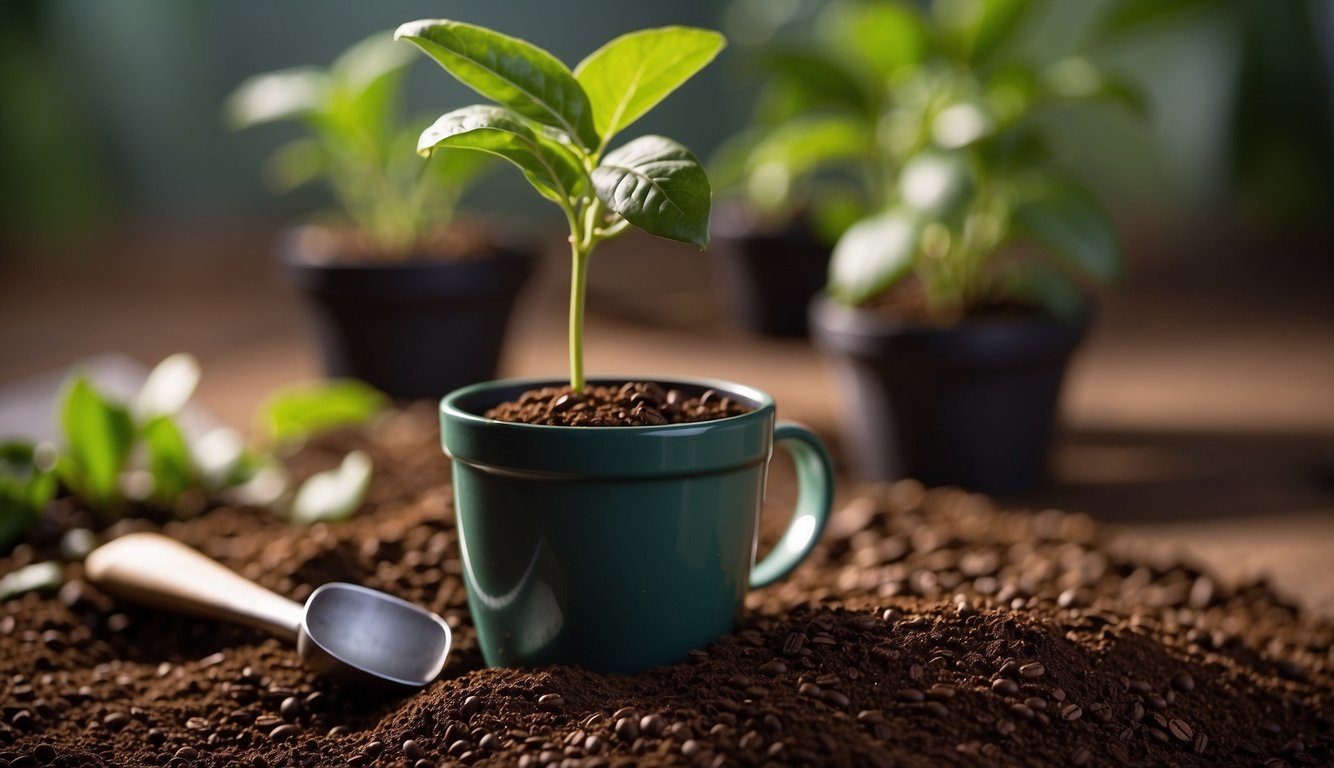
As a coffee lover, I have found that coffee grounds are a great source of nutrients for potted plants. However, it is important to prepare the coffee grounds properly before using them in your plants. In this section, I will discuss how to dry and store coffee grounds and how to create a coffee ground compost mix.
Drying and Storing Coffee Grounds
Before using coffee grounds in your potted plants, it is important to dry them properly. Wet coffee grounds can cause mold and attract pests, which can harm your plants. To dry your coffee grounds, spread them out on a flat surface such as a paper towel or a baking sheet. Allow the coffee grounds to dry completely before storing them.
Once your coffee grounds are dry, you can store them in an airtight container. This will help prevent moisture from getting in and keep your coffee grounds fresh. You can store your coffee grounds in the kitchen or in a pantry.
Creating a Coffee Ground Compost Mix
Coffee grounds can also be used as a compost ingredient. Composting it can help reduce waste and create a nutrient-rich soil amendment for your potted plants. To create a coffee ground compost mix, follow these steps:
- Collect coffee grounds from your kitchen or local coffee shop.
- Add the coffee grounds to your compost bin along with other compostable materials such as paper and food scraps.
- Mix the compost materials together and add water to moisten the mixture.
- Turn the compost pile regularly to help speed up the composting process.
- Once the compost is finished, you can use it as a soil amendment for your potted plants.
Using a coffee ground compost mix can help improve soil structure and provide essential nutrients for your potted plants. However, it is important to use the compost mix in moderation as too much can be harmful to your plants.
In summary, preparing coffee grounds for use in potted plants involves drying and storing them properly and creating it compost mix. By following these steps, you can provide your plants with a source of nutrients and reduce waste at the same time.
Applying Coffee Grounds to Potted Plants
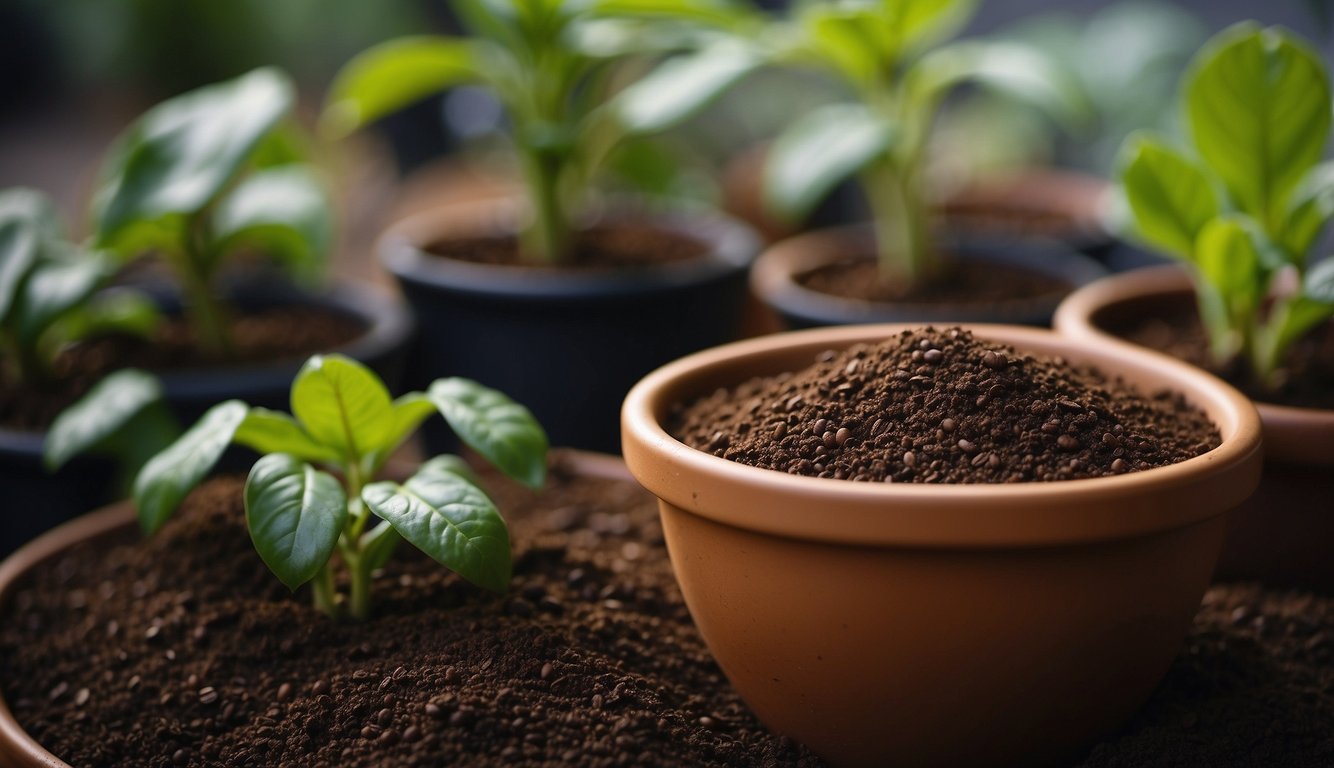
As an avid plant owner, I have found that using coffee grounds in my potted plants has been a great way to supplement their growth and keep them healthy. Here are a few methods that I have found to be effective:
Direct Application Methods
Directly applying coffee grounds to the soil of potted plants can be a great way to add nutrients to the soil. However, it is important to note that coffee grounds can be acidic and should be used sparingly. I usually mix a small amount of coffee grounds with the potting mix before planting my plants. This ensures that the coffee grounds are evenly distributed and won’t cause any issues with the pH level of the soil.
Another way to use coffee grounds directly is to sprinkle them on top of the soil around the base of the plant. This can help with water retention and moisture level in the soil. However, it is important to note that coffee grounds can form a hard layer on top of the soil, which can prevent water from draining properly. To avoid this, I make sure to mix the coffee grounds into the soil or break up the layer on top of the soil regularly.
Liquid Coffee Ground Fertilizer
Another way to use coffee grounds in potted plants is to make a liquid fertilizer. To do this, I mix used coffee grounds with water and let it sit for a few days to create a concentrated liquid. I then dilute the mixture with water and use it to water my plants.
This method can be especially beneficial for houseplants, as it provides a quick boost of nutrients to the soil. However, it is important to note that the coffee grounds should be filtered out before using the liquid fertilizer, as they can clog the drainage holes in the pot.
Overall, using coffee grounds in potted plants can be a great way to supplement plant care and provide a natural fertilizer. Just remember to use them in moderation and be mindful of their acidity levels.
Understanding Soil pH and Coffee Grounds
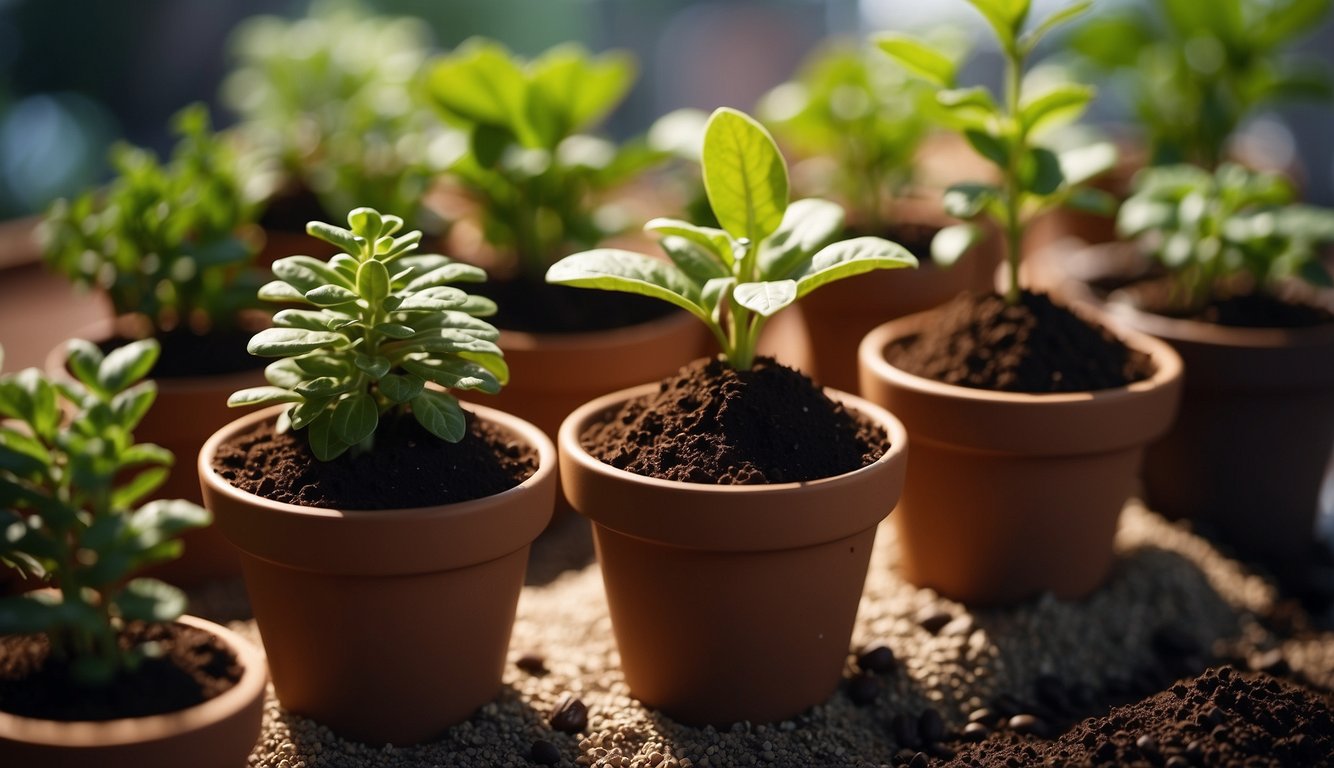
As a plant enthusiast, I know that the pH level of the soil is crucial to the success of plant growth. The pH level determines the acidity or alkalinity of the soil, which affects the availability of nutrients. Coffee grounds can be used as a fertilizer for potted plants, but it is essential to understand their effects on soil acidity.
Effects on Soil Acidity – How to Use Coffee Grounds in Potted Plants?
Coffee grounds are acidic, with a pH of around 5.2 to 6.9, depending on the type of coffee and the brewing method. When added to the soil, coffee grounds can lower the pH level, making the soil more acidic. This can be beneficial for plants that prefer acidic soil, such as African violets and hydrangeas.
However, it is essential to use coffee grounds in moderation, as too much can make the soil too acidic and harm the plants. It is recommended to mix one part coffee grounds with four parts soil to maintain a healthy pH level.
Choosing the Right Plants for Coffee Grounds
Before using coffee grounds as a fertilizer, it is crucial to consider the needs of the plants. Acid-loving plants, such as African violets, azaleas, and blueberries, can benefit from coffee grounds. These plants thrive in acidic soil and can absorb the nutrients from the coffee grounds.
On the other hand, plants that prefer alkaline soil, such as asparagus ferns, may not benefit from coffee grounds. Adding coffee grounds to alkaline soil can make it more acidic, which can harm the plants.
It is also important to note that coffee grounds are not a significant source of phosphorous, a vital nutrient for plant growth. Therefore, it is essential to use other fertilizers in conjunction with coffee grounds to provide a balanced nutrient profile for the plants.
In summary, coffee grounds can be a useful fertilizer for potted plants, but it is essential to understand their effects on soil acidity. Using coffee grounds in moderation and choosing the right plants can help maintain a healthy pH level and promote plant growth.
Potential Issues and How to Avoid Them – How to Use Coffee Grounds in Potted Plants?
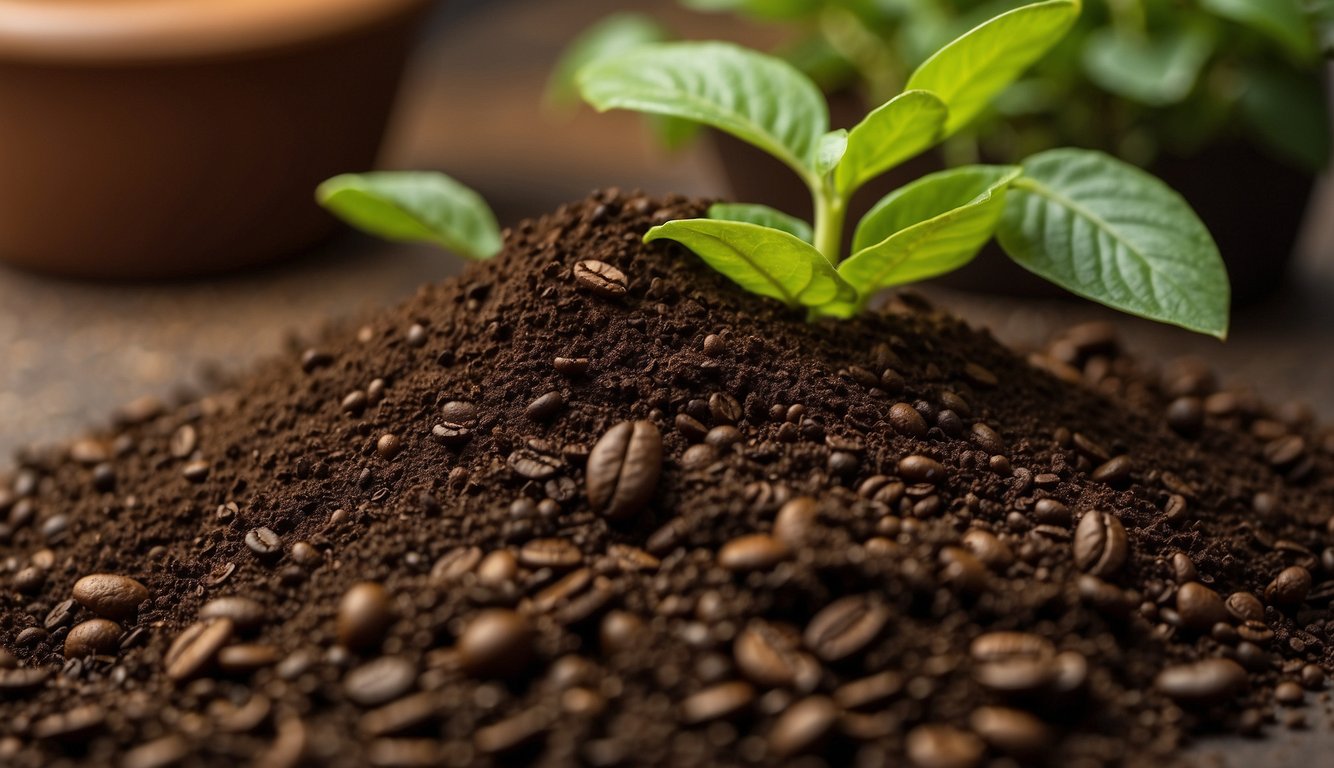
When using coffee grounds in potted plants, it is important to be aware of potential issues that may arise. Here are some common problems and how to avoid them.
Preventing Overwatering and Poor Drainage – How to Use Coffee Grounds in Potted Plants?
One issue that can arise from using coffee in potted plants is overwatering. Coffee grounds can absorb a lot of moisture, which can lead to waterlogged soil and poor drainage. To prevent overwatering, it is important to mix the coffee grounds with other materials that promote drainage, such as perlite or sand.
It is also important to ensure that the pot has drainage holes at the bottom to allow excess water to drain out. If the soil becomes waterlogged, it can lead to root rot and other issues that can harm the plant.
Avoiding Toxicity and Over-Fertilization
Another potential issue with using coffee grounds in potted plants is toxicity and over-fertilization. Coffee grounds are acidic, which can be harmful to some plants, particularly those that prefer neutral or alkaline soil.
To avoid toxicity, it is important to use coffee grounds sparingly and mix them with other materials to dilute their acidity. It is also important to monitor the pH level of the soil to ensure that it remains within the appropriate range for the plant.
Over-fertilization can also be a problem when using coffee grounds in potted plants. Coffee grounds are high in nitrogen, which can promote lush foliage growth but can also lead to excessive vegetative growth at the expense of flowers or fruit.
To avoid over-fertilization, it is important to use coffee grounds in moderation and in combination with other fertilizers that provide a balanced nutrient profile. It is also important to monitor the plant’s growth and adjust the fertilizer regimen as needed.
By being aware of these potential issues and taking steps to prevent them, you can use coffee grounds effectively in potted plants without harming the plant. Keep in mind that different plants have different needs, so it is important to research the specific requirements of your plant before adding coffee grounds to the soil.
Eco-Friendly Practices with Coffee Grounds – How to Use Coffee Grounds in Potted Plants?
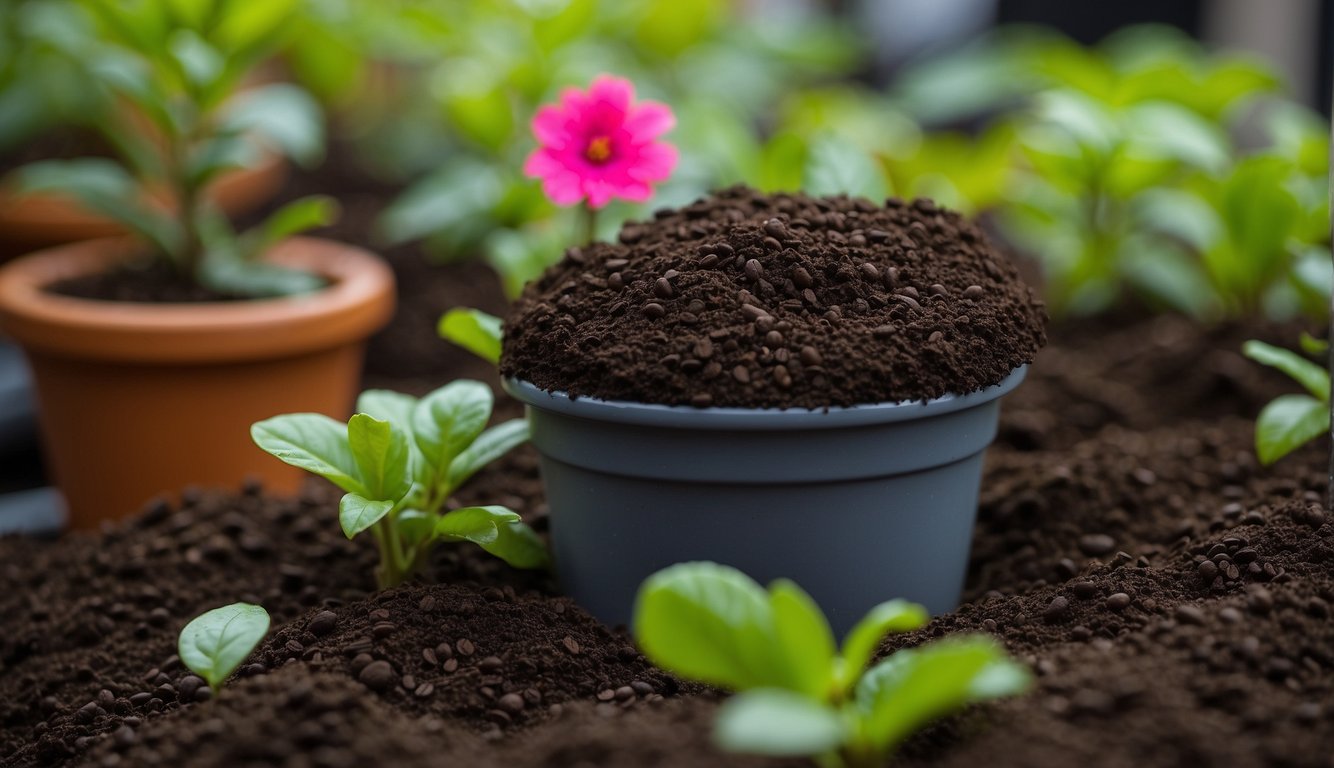
Recycling Coffee Grounds from the Kitchen
As an avid coffee drinker, I am always looking for ways to recycle my coffee grounds instead of throwing them away. One of the best ways to recycle it is by using them in potted plants. Coffee grounds are an excellent source of nitrogen, which is essential for plant growth. When used as a soil amendment, coffee grounds can improve soil structure, increase water retention, and provide nutrients to the plants.
To recycle coffee grounds from the kitchen, I collect them in a container and store them in the refrigerator until I have enough to use in my potted plants. Alternatively, I can add them directly to the soil around the plants. It’s important to note that coffee grounds are acidic, so it’s best to use them in plants that prefer acidic soil, such as blueberries, tomatoes, and roses.
Promoting Environmental Sustainability – How to Use Coffee Grounds in Potted Plants?
Using coffee grounds in potted plants is not only an excellent way to recycle kitchen waste, but it is also an eco-friendly practice that promotes environmental sustainability. Worldwide, billions of cups of coffee are consumed every day, and the waste generated from this consumption can have a significant impact on the environment. By recycling coffee grounds, we are reducing the amount of waste that ends up in landfills and promoting a more sustainable way of living.
In addition to using coffee grounds in potted plants, there are other ways to recycle coffee grounds, such as using them as mulch, adding them to compost, or using them as an ingredient in homemade beauty products. By incorporating coffee grounds into our daily lives, we can reduce our environmental footprint and promote a more sustainable future.
Additional Uses of Coffee Grounds in the Garden
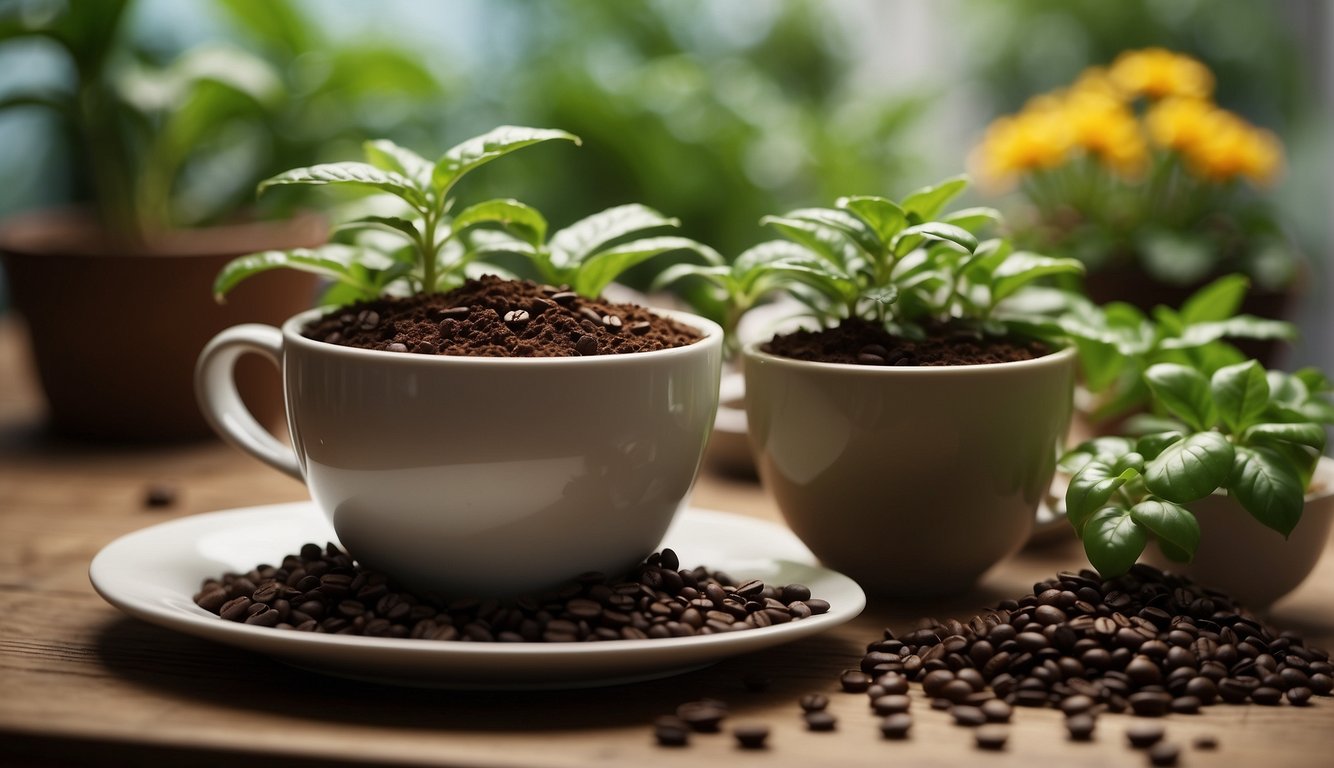
Coffee grounds are not only beneficial for potted plants, but they can also be used in various ways in the garden. Here are some additional uses of coffee grounds that you can try:
Mulching with Coffee Grounds – How to Use Coffee Grounds in Potted Plants?
Mulching with coffee grounds can help improve soil quality and suppress weeds. Coffee grounds are rich in nitrogen, phosphorus, and potassium, which are essential nutrients for plant growth. When used as mulch, coffee grounds can help retain soil moisture, regulate soil temperature, and prevent soil erosion.
To use coffee grounds as mulch, simply spread a layer of coffee grounds around the base of your plants. Make sure to avoid piling the coffee grounds too high, as this can create a barrier that prevents water from reaching the plant roots.
Companion Planting with Coffee Grounds
Companion planting is a gardening technique that involves planting different crops together to benefit each other. Coffee grounds can be used as a companion plant to help repel pests and improve soil quality.
For example, coffee grounds can be used to repel slugs and snails when planted alongside hostas and tomatoes. Coffee grounds can also be used to improve soil quality when planted alongside clover and other legumes.
Coffee grounds can be used as a natural fertilizer for plants that prefer acidic soil, such as hydrangeas, peace lilies, and philodendrons. However, it is important to note that coffee grounds should be used in moderation, as they can make the soil too acidic over time.
Overall, coffee grounds can be a valuable addition to your gardening routine. Just remember to use them in moderation and avoid using them on plants that prefer alkaline soil.
How to Use Coffee Grounds in Potted Plants?
Today, we’re brewing up some knowledge about using coffee grounds in potted plants. Get ready, it’s going to be a caffeinated ride!
Firstly, let’s talk about coffee grounds. They’re rich in nitrogen, a nutrient that plants love. It’s like a morning coffee for your plants!
Now, the how-to part. Simply sprinkle the coffee grounds on top of the soil. It’s as easy as making your morning brew!
And here’s a fun fact! Coffee grounds can help improve soil structure and drainage. It’s like a mini renovation for your pot!
So, next time you’re enjoying a cup of joe, remember to save the grounds. Your potted plants will thank you!
For more plant care tips, do visit the website theherbprof.com. Keep it green, folks!
References – How to Use Coffee Grounds in Potted Plants?
Little Herb Encyclopedia, by Jack Ritchason; N.D., Woodland Publishing Incorporated, 1995
The Ultimate Healing System, Course Manual, Copyright 1985, Don Lepore
Planetary Herbology, Michael Tierra, C.A., N.D., Lotus Press, 1988
Handbook of Medicinal Herbs, by James A. Duke, Pub. CRP Second Edition 2007
The Complete Medicinal Herbal, by Penelope Ody, Published by Dorling Kindersley
Check the Following Articles!
How to Clean Up Grass Clippings: Tips and Tricks
Weird Vegetables to Grow: Unique and Uncommon Varieties
Feeding Tomatoes: Tips for Optimal Growth
Frequently Asked Questions – How to Use Coffee Grounds in Potted Plants?
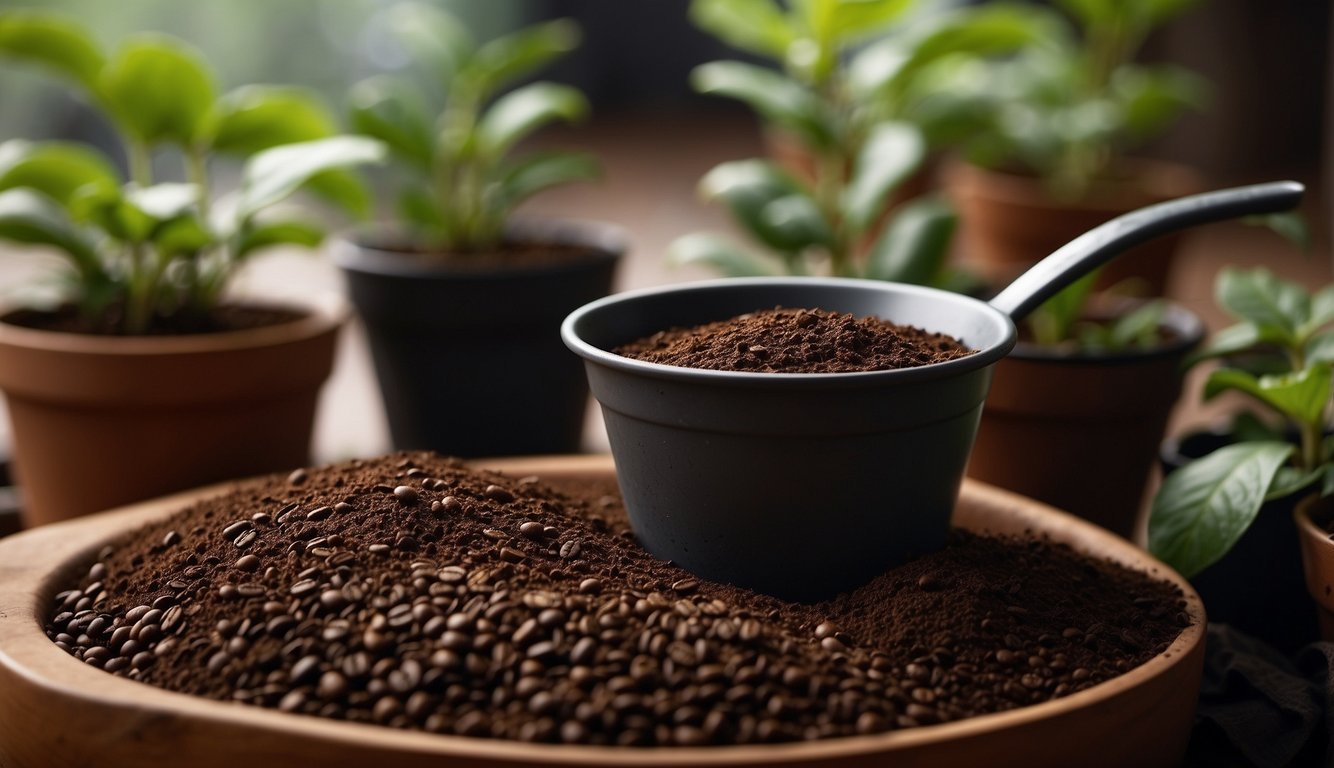
What are the benefits of using coffee grounds for potted plants?
Coffee grounds can provide a variety of benefits to potted plants. They are a natural source of nitrogen, phosphorus, and potassium, which are essential nutrients for plant growth. Coffee grounds can also improve soil structure and drainage, and help to maintain a consistent soil pH level. Additionally, coffee grounds can act as a natural pest repellent, helping to keep unwanted insects away from your potted plants.
Which potted plants can be improved by adding coffee grounds?
Many potted plants can benefit from the addition of coffee grounds. Acid-loving plants, such as azaleas, rhododendrons, and blueberries, thrive in soil that is slightly acidic, and coffee grounds can help to maintain the appropriate pH level. Other plants that can benefit from coffee grounds include jade plants, peace lilies, African violets, and Christmas cacti.
How can you apply coffee grounds to indoor potted plants effectively?
To apply coffee grounds to indoor potted plants effectively, it is important to mix them into the soil or use them as a top dressing. When mixing coffee grounds into the soil, be sure to use a small amount and work it in thoroughly to avoid creating clumps that could block water and air flow. As a top dressing, coffee grounds can be sprinkled on the surface of the soil and gently worked in with a fork or trowel.
Are there any risks associated with using coffee grounds for houseplants?
While coffee grounds can provide many benefits to potted plants, there are some risks associated with their use. Coffee grounds can be acidic, and if used in excess, they can lower the pH level of the soil, making it too acidic for some plants. Additionally, coffee grounds can contain caffeine, which can be harmful to some plants, and can attract unwanted pests if left on the surface of the soil.
How frequently should coffee grounds be added to potted plants for optimal growth?
The frequency at which coffee grounds should be added to potted plants will depend on the specific plant and its individual needs. In general, it is best to add coffee grounds sparingly, and to monitor the pH level of the soil to ensure that it remains within the appropriate range. Overuse of coffee grounds can lead to soil that is too acidic, which can harm plants.
Can coffee grounds be used as a fertilizer for all types of potted vegetables?
While coffee grounds can provide many benefits to potted plants, they may not be suitable for all types of potted vegetables. Some vegetables, such as tomatoes and peppers, prefer soil that is slightly acidic, and can benefit from the addition of coffee grounds. However, other vegetables, such as beans and peas, prefer soil that is neutral to slightly alkaline, and may not benefit from the addition of coffee grounds. It is important to research the specific needs of your potted vegetables before using coffee grounds as a fertilizer.
